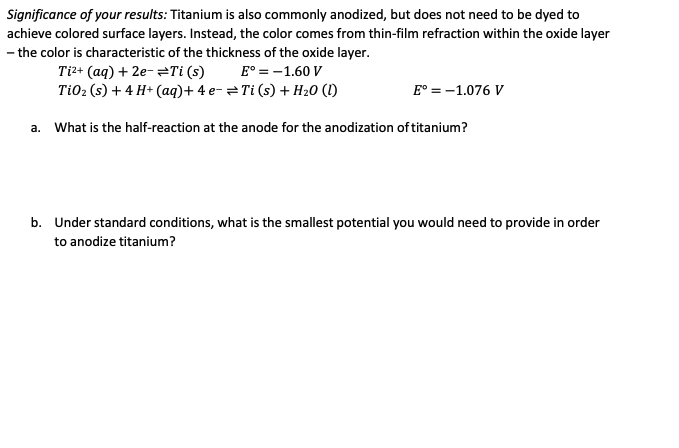Significance of your results: Titanium is also commonly anodized, but does not need to be dyed to achieve colored surface layers. Instead, the color comes from thin-film refraction within the oxide layer - the color is characteristic of the thickness of the oxide layer. Ti²+ (aq) + 2e-Ti (s) E° = -1.60 V TiO₂ (s) + 4 H+ (aq) + 4 e− = Ti (s) + H₂0 (1) a. What is the half-reaction at the anode for the anodization of titanium? E° = -1.076 V b. Under standard conditions, what is the smallest potential you would need to provide in order to anodize titanium?
Significance of your results: Titanium is also commonly anodized, but does not need to be dyed to achieve colored surface layers. Instead, the color comes from thin-film refraction within the oxide layer - the color is characteristic of the thickness of the oxide layer. Ti²+ (aq) + 2e-Ti (s) E° = -1.60 V TiO₂ (s) + 4 H+ (aq) + 4 e− = Ti (s) + H₂0 (1) a. What is the half-reaction at the anode for the anodization of titanium? E° = -1.076 V b. Under standard conditions, what is the smallest potential you would need to provide in order to anodize titanium?
Chemistry for Engineering Students
4th Edition
ISBN:9781337398909
Author:Lawrence S. Brown, Tom Holme
Publisher:Lawrence S. Brown, Tom Holme
Chapter13: Electrochemistry
Section: Chapter Questions
Problem 13.29PAE
Related questions
Question

Transcribed Image Text:Significance of your results: Titanium is also commonly anodized, but does not need to be dyed to
achieve colored surface layers. Instead, the color comes from thin-film refraction within the oxide layer
- the color is characteristic of the thickness of the oxide layer.
Ti²+ (aq) + 2e-Ti (s) E° = -1.60 V
TiO₂ (s) + 4 H+ (aq) + 4 e-Ti (s) + H₂0 (1)
E° = -1.076 V
a. What is the half-reaction at the anode for the anodization of titanium?
b. Under standard conditions, what is the smallest potential you would need to provide in order
to anodize titanium?
Expert Solution
This question has been solved!
Explore an expertly crafted, step-by-step solution for a thorough understanding of key concepts.
Step by step
Solved in 4 steps

Knowledge Booster
Learn more about
Need a deep-dive on the concept behind this application? Look no further. Learn more about this topic, chemistry and related others by exploring similar questions and additional content below.Recommended textbooks for you

Chemistry for Engineering Students
Chemistry
ISBN:
9781337398909
Author:
Lawrence S. Brown, Tom Holme
Publisher:
Cengage Learning


Principles of Instrumental Analysis
Chemistry
ISBN:
9781305577213
Author:
Douglas A. Skoog, F. James Holler, Stanley R. Crouch
Publisher:
Cengage Learning

Chemistry for Engineering Students
Chemistry
ISBN:
9781337398909
Author:
Lawrence S. Brown, Tom Holme
Publisher:
Cengage Learning


Principles of Instrumental Analysis
Chemistry
ISBN:
9781305577213
Author:
Douglas A. Skoog, F. James Holler, Stanley R. Crouch
Publisher:
Cengage Learning

Chemistry for Engineering Students
Chemistry
ISBN:
9781285199023
Author:
Lawrence S. Brown, Tom Holme
Publisher:
Cengage Learning